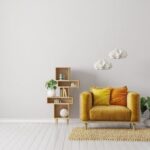Thinking of revamping your home decor? Learn how to use home decor chalk paint to transform your furniture and accessories with a shabby chic, vintage-inspired look. Chalk paint has surged in popularity for its ability to effortlessly upgrade ordinary items into stylish statement pieces. In this comprehensive guide, we will delve into the world of home decor chalk paint, covering everything from its history and benefits to the step-by-step process and maintenance tips for achieving professional results.
Home decor chalk paint has quickly become a favorite among DIY enthusiasts and interior designers alike due to its remarkable versatility and minimal prep work requirements. Whether you’re looking to breathe new life into an old wooden dresser or add a distressed finish to metal hardware, chalk paint offers endless possibilities for creative expression. With the right guidance, you can harness the power of this transformative medium to elevate your living space with personalized charm.
In this article, we will provide valuable insights on choosing the right surfaces for chalk painting, essential tools and materials needed for a successful project, as well as expert tips for achieving professional finishes. From prepping surfaces and selecting suitable brushes to mastering various painting techniques such as distressing and layering, you’ll learn how to seamlessly integrate home decor chalk paint into your next creative endeavor.
So grab your overalls and let’s get ready to unleash your inner artist.
Choosing the Right Surface for Chalk Painting
Choosing the right surface is crucial for a successful chalk painting project. While chalk paint is known for its versatility, certain surfaces may require different preparation and techniques to achieve the desired result. Here are some tips for choosing the right surface for your next chalk painting endeavor:
- Wood: Wood is an ideal surface for chalk painting due to its porous nature, which allows the paint to adhere easily. When painting wood furniture or decor, it’s important to sand any rough areas and apply a primer before applying chalk paint.
- Metal: Chalk painting metal surfaces can give them a beautiful and unique finish. Before painting metal items such as lamps or picture frames, be sure to clean and dry the surface thoroughly, and consider using a metal-appropriate primer for better adhesion.
- Glass: Chalk painting glass objects can create stunning decorative pieces. To ensure the paint adheres well to glass, it’s essential to clean the surface with rubbing alcohol and use a bonding primer specifically designed for glass surfaces.
Each surface presents its own set of challenges and considerations when chalk painting, but with the right preparation and techniques, you can achieve professional results on any material. Remember to always experiment on a small area first before tackling larger projects to ensure the best outcome.
Carefully selecting the appropriate surface for your chalk painting project will ultimately determine the longevity and overall look of your finished piece. Whether you’re updating old furniture or adding a decorative touch to everyday items, understanding how different materials interact with chalk paint will help you achieve beautiful and lasting results in your home decor endeavors.
The Essential Tools and Materials for Chalk Painting
Home decor chalk paint has become a popular choice for revamping furniture and decor, thanks to its ease of use and versatile finish. To embark on your own chalk painting projects, you will need the essential tools and materials to ensure a successful outcome. Here is a breakdown of the necessary supplies you will need for your chalk painting endeavors:
- Chalk Paint: Of course, the most important item on your list is the chalk paint itself. There are various brands and color options available, so choose one that suits your project and personal style.
- Brushes: Invest in high-quality brushes specifically designed for chalk painting. Look for brushes with natural bristles that can hold the thick consistency of chalk paint.
- Sandpaper: Before painting, it’s crucial to prep the surface by sanding it to create a smooth base. Different grits of sandpaper may be needed depending on the condition of the surface.
- Protective Finishes: After applying the chalk paint, protect your project with a finishing wax or sealant. This step not only adds durability but also enhances the overall look of the painted surface.
For beginners looking to explore chalk painting without breaking the bank, there are budget-friendly options available for each of these essential tools and materials. As you gain experience and confidence in your painting skills, you can gradually invest in higher-end supplies for more advanced projects.
Step-by-Step Chalk Painting Process
Chalk painting is a versatile and popular option for home decor projects, as it can easily transform everyday items into beautifully refreshed pieces. Whether you’re looking to update old furniture or add a personal touch to decor accents, the step-by-step chalk painting process can be both simple and rewarding.
Start by preparing the surface for painting. Clean the item thoroughly with soap and water, then sand any rough spots to create a smooth surface for the paint to adhere to. Use a damp cloth to remove any dust or debris from sanding before beginning the next step.
Next, apply the first coat of chalk paint using even brush strokes. It’s important to let each coat dry completely before adding another layer, which typically takes about one hour. Depending on the desired look and coverage, two or three coats of paint may be needed.
Once the final coat has dried, consider distressing or layering techniques to add visual interest to your piece. Sandpaper can be used to create a worn or weathered look in certain areas, while layering different colors of chalk paint can provide depth and dimension.
| Step | Description |
|---|---|
| 1 | Prepare the surface by cleaning and sanding |
| 2 | Apply multiple coats of chalk paint with drying time in between |
| 3 | Consider distressing or layering techniques for added visual interest |
Tips for Achieving a Professional Finish
When using chalk paint for home decor projects, achieving a professional finish is essential for creating a polished and high-quality result. To achieve this, start by making sure your surface is clean and smooth. Any imperfections on the surface will show through the paint, so it’s important to sand down any rough spots and fill in any holes or dents with wood filler.
Once your surface is prepped, choose the right brush for your project. A natural-bristle brush is typically recommended for chalk paint as it holds the paint well and allows for easy application on different surfaces. Additionally, always apply multiple thin coats of chalk paint rather than one thick coat to avoid drips and streaks that can detract from the final look.
Finally, remember to seal your chalk painted surface with a protective finish. There are various options available, including wax and polyurethane. Apply the protective finish evenly across the entire painted surface using a high-quality brush or lint-free cloth.
| Tip | Description |
|---|---|
| Proper Surface Preparation | Ensure that your surface is clean, smooth, and free of imperfections before painting. |
| Choose the Right Brush | Use a natural-bristle brush to achieve even coverage and smooth application. |
| Apply Thin Coats | Avoid drips and streaks by applying multiple thin coats of chalk paint. |
Adding Decorative Finishes to Chalk Painted Projects
When it comes to chalk painted projects, the creative possibilities are endless. Once you have applied the base coat of chalk paint and achieved your desired finish, you can take your project to the next level by adding decorative finishes. From subtle wax accents to eye-catching metallic details, there are numerous ways to enhance and personalize your chalk painted furniture and decor.
Enhancing With Wax and Glaze
One popular way to add depth and character to chalk painted projects is by using wax or glaze finishes. These products can be applied over the dried chalk paint to create a subtle sheen or an aged appearance. Clear waxes provide a protective layer while dark waxes can be used for distressing effects. Glazes come in various colors and can be used to tint or antique the surface for a unique look.
Embellishing With Metallic Accents
For those looking to bring a touch of glamour to their chalk painted projects, metallic accents offer a modern and elegant finish. Metallic waxes or paints can be used to highlight edges, details, or entire surfaces for a stunning effect. Whether it’s gold, silver, copper, or bronze, metallic finishes can elevate the overall look of your piece.
Personalizing With Stencils and Decals
To truly make your chalk painted project one-of-a-kind, consider using stencils or decals to add personalized designs or patterns. Stencils offer a way to create intricate motifs or borders, while decals allow for easy application of quotes, monograms, or images. With a wide variety of options available, you can let your creativity shine through when adding these decorative touches.
By incorporating these decorative finishes into your chalk painted projects, you can elevate the overall look and feel of your furniture and decor. Whether you prefer a vintage distressed look, a sleek metallic finish, or personalized embellishments, these techniques are sure to inspire creativity in your DIY endeavors.
Maintenance and Care for Chalk Painted Surfaces
Proper Cleaning Techniques
One of the benefits of using chalk paint for home decor projects is its durability, but it’s still essential to take care when cleaning chalk painted surfaces. For routine cleaning, simply use a damp cloth to gently wipe down the surface. Avoid using harsh chemicals or abrasive cleaning tools, as these can damage the finish of the paint.
For tougher stains or dirt buildup, mild soap and water can be used to spot clean the area. Be sure to dry the surface thoroughly after cleaning to prevent any moisture from affecting the paint. By following these simple cleaning techniques, you can keep your chalk painted surfaces looking their best for years to come.
Protective Finishes
To prolong the life of your chalk painted furniture and decor, consider applying a protective finish. This additional layer not only adds an extra level of durability but also helps to seal and protect the paint from everyday wear and tear. Various options are available, including wax and polyurethane, each offering different levels of sheen and protection.
When applying a protective finish, follow the manufacturer’s instructions carefully to ensure proper coverage and drying time. Additionally, consider reapplying the protective finish every few years as part of regular maintenance to keep your chalk painted surfaces in top condition.
Refreshing Chalk Painted Surfaces
Over time, even well-maintained chalk painted surfaces may begin to show signs of wear. Thankfully, refreshing these areas is a straightforward process. Begin by lightly sanding any rough or uneven areas before applying a new coat of chalk paint. This will help smooth out imperfections and provide a fresh canvas for painting.
After adding a new coat of chalk paint, follow up with another layer of protective finish for added longevity. With this simple process, you can easily revitalize your chalk painted items without having to completely strip or refinish them.
Inspiring Chalk Paint DIY Projects
In conclusion, home decor chalk paint is a versatile and popular choice for DIY projects. From furniture makeovers to small decorative items, the possibilities are endless when it comes to using chalk paint to revamp and personalize your living space. By following the step-by-step process outlined in this article and utilizing the essential tools and materials, readers can confidently tackle their own chalk paint projects with ease.
The added bonus of using chalk paint is the ability to achieve professional finishes with ease, thanks to expert advice and troubleshooting tips provided in this guide. Whether it’s achieving a smooth and even finish or adding decorative accents with wax, glaze, or metallic touches, readers are empowered to take their DIY projects to the next level.
Furthermore, proper maintenance and care are essential for ensuring long-lasting results with chalk painted surfaces. By following the guidance on how to clean and refresh chalk painted items when needed, readers can enjoy their personalized creations for years to come. Overall, this article serves as a comprehensive resource for individuals looking to explore the world of home decor chalk paint and embark on inspiring DIY projects for their home.
Frequently Asked Questions
What Is Home Decor Chalk Used For?
Home decor chalk is used for adding a vintage, distressed, or shabby chic look to furniture and decor items. It can be used on wood, metal, glass, ceramic, and even fabric to create a matte, chalky finish that gives a unique and customized look to various surfaces.
What Is the Best Way to Use Chalk Paint?
The best way to use chalk paint is to start with clean and dry surfaces, then apply the paint using a roller, brush, or sprayer in thin coats. Lightly sand between coats for a smooth finish and seal the painted surface with wax or polyurethane for added durability and protection.
Chalk paint can also be easily distressed using sandpaper to achieve a more weathered appearance.
What Not to Do With Chalk Paint?
When using chalk paint, it’s important not to skip the step of sealing the painted surface with wax or polyurethane, as this helps protect the finish from wear and tear. Additionally, avoid using too much water when cleaning chalk-painted surfaces, as it can cause the paint to lift or peel.
Finally, do not use chalk paint on outdoor furniture or surfaces without proper sealing and protection, as it is not designed for prolonged exposure to the elements.

I’m thrilled to be your companion on this exciting journey through the world of home decor and design. With a passion for turning houses into homes and a keen eye for the finer details, I’m here to help you transform your living spaces into beautiful, functional, and meaningful havens.





